Authors: Charles Ware, Yi Zhu

A Virtuous Setting
Situated near the confluence of the Xicheng Canal and the Yangtze River, Beimen Island stands as the vibrant heart of Jiangyin, poised amidst a dynamic landscape. It thrives on its interconnectedness, forging links with the bustling Binjiang Business District to the north, an enchanting historic quarter to the east, and expansive residential areas to the west. As the sole true island within the city, it derives its vitality from its pivotal location along a major urban development axis stretching from east to west, and the vital north-south canal corridor. This convergence marks the epicenter of Jiangyin’s future urban development.
The island emerged as an ideal site for a significant cultural landmark and urban catalyst, owing to its strategic position, its intrinsic allure as an island enclave, its adjacency to pedestrian-friendly historic districts, and the city’s rich legacy as a cultural hub. Framed by canals that offer sweeping vistas of Junshan mountain and the venerable Beidajie historic neighborhoods, the island itself embodies a distinct historical epoch, characterized by sensitively preserved yarn factory buildings and a mature landscape.
The metropolitan area abounds with a wealth of historic, cultural, and tourism sites, complemented by expansive nature parks and open space corridors. Renowned for its magnificent garden landscapes and vibrant musical heritage, the city draws regional visitors. Traditional Chinese music flourishes in Jiangyin, deeply ingrained in the local fabric. The city proudly hosts seventy orchestras, thirty music schools, and nine examination institutions dedicated to the preservation and advancement of Chinese folk music.[1]
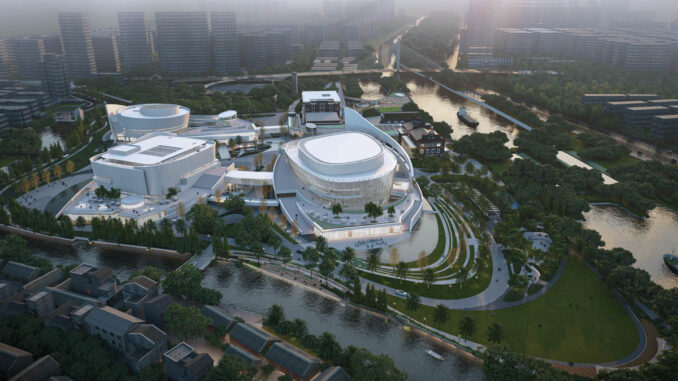
A Vision Informed by History and Context
Architects and landscape architects joined forces to conceive and craft the 13-hectare China National Music Center campus, solidifying Jiangyin’s status as the revered birthplace of traditional Chinese music. Nestled in the core of Jiangyin, the campus transcends mere musical boundaries, seamlessly integrating history, culture, science, art, and contemporary public spaces. Once an industrial hub for textiles, the island has undergone a remarkable transformation into a “park island” landscape, purposefully knitting the center into the fabric of its urban surroundings. At its core lies a fundamental design ethos that mirrors the very essence of traditional Chinese music—fluid, rhythmic, and profoundly connected to nature.
Key to the vision is the seamless integration of the island with its surrounding neighborhoods. Serving as the vibrant heart of these communities, the Music Center acts as a unifying force, fostering a sense of belonging and cohesion. Ensuring accessibility for all, the center is connected to its surroundings via a network of bridges on all sides of the island. Each bridge is distinctively received on the campus with gardens and other destination spaces.
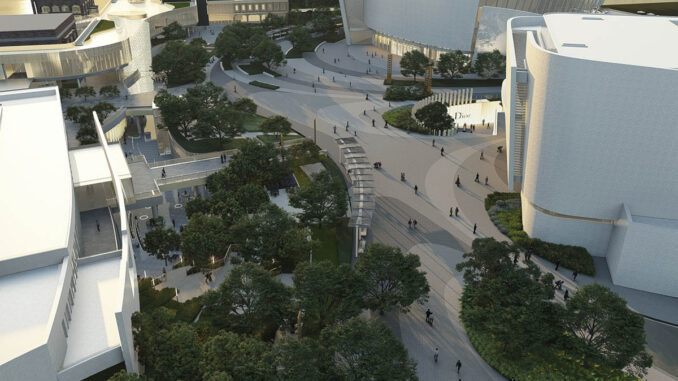
Conceptual Framework
The campus core embodies the concept of “flowing space and forms,” drawing inspiration from both the melodic rhythms of traditional Chinese music and the sinuous waterways of Jiangyin. This notion permeates landscape and architectural design, evident in the meandering pathways and the graceful contours of structures such as the music center, art galleries, and science museums. These spaces are dynamic hubs, carefully programmed to engage the public and pay homage to Jiangyin’s vibrant cultural heritage as the historic cradle of Chinese traditional music.
Campus design springs from several complementary organizing elements: art, nature, and history. These elements are interwoven as a foundation from which music is celebrated.
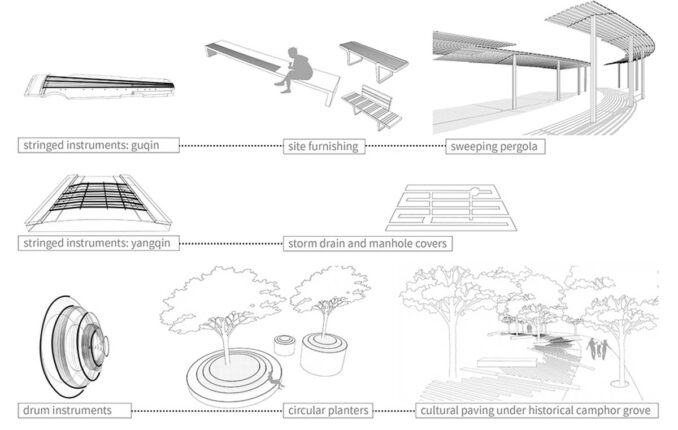
Art: Harmony and Expression
Both two- and three-dimensional art are thoughtfully woven into the fabric of the campus design, seamlessly embedded within the sinuous contours of the landscape and architectural structures, creating a harmonious visual symphony. These artistic elements not only enhance the aesthetic appeal but also contribute to the choreography of movement and rhythm throughout the campus. Every space becomes a canvas, each pathway a stanza, collectively composing a poetic narrative that resonates with the melodic spirit of music.
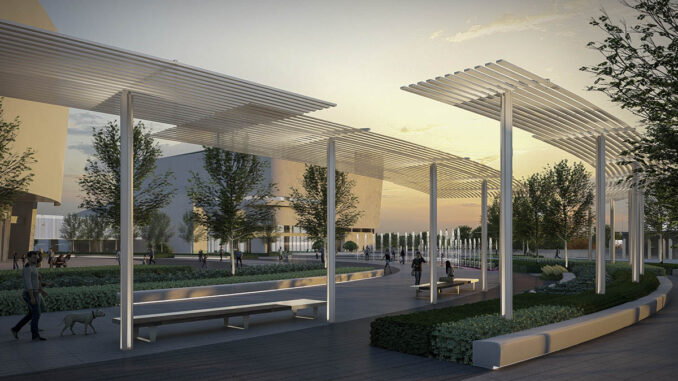
Throughout the site, subtle nods to musical instruments are cleverly incorporated into the architecture, furnishings, and crafted details. Particularly notable are references to string instruments like the guqin, zheng, erhu, and pipa, which hold special significance in Chinese music, particularly in the Jiangnan region.[2] A graceful pergola, for instance, elegantly mirrors the “strings” and tuning “pins” found on these instruments, forming fundamental elements of its structure. Additionally, bench details artfully abstract the delicate strings of a guqin, infusing the setting with a harmonious blend of music and design.
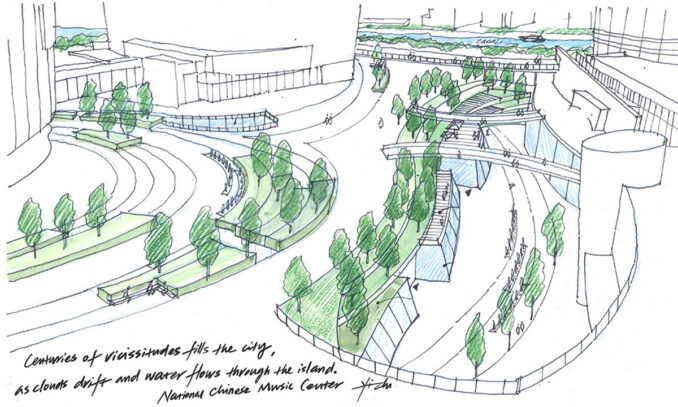
Nature-Inspired Abstractions Fluid, eccentric forms reverberate from elliptical buildings. Contrasting forms emerge along the meandering canal waterfront, where garden paths, seasonal planting bands, and graceful tree lines intertwine. These figuratively crafted landscapes, though constructed, seamlessly interact with the architectural elements, creating a mesmerizing interplay of forms and textures. As the manufactured and natural realms converge, the resulting landscape becomes a captivating tableau of fluidity and complexity—an abstract island where water and artistry intertwine perfectly.
Historic Juxtapositions
Situated north of majestic mountains and nestled along the southern bank of the Yangtze River, Jiangyin—known as the “Yin of the Great River”—stands as a pivotal transportation hub along this iconic waterway. With a storied history spanning over a millennium, the city has thrived as a bustling international port and industrial center. Yet, amidst its gritty urban landscape, Jiangyin boasts a cultural legacy dating back 2,500 years, layered with historic gardens, temples, ancient ruins, and vibrant festivals. It is this rich tapestry of heritage and tradition that serves as the guiding inspiration for the National Chinese Music Center.
Embracing Jiangyin’s Riverine Heritage
In homage to Jiangyin’s intrinsic connection to its waterways, the campus design integrates water elements that pay tribute to the surrounding canals enveloping the island. These aquatic features collectively enchant visitors, offering a series of captivating visual experiences. The gentle flow of water not only enhances the aesthetic appeal but also creates a tranquil auditory backdrop, inviting individuals to immerse themselves in the serene ambiance of the campus.
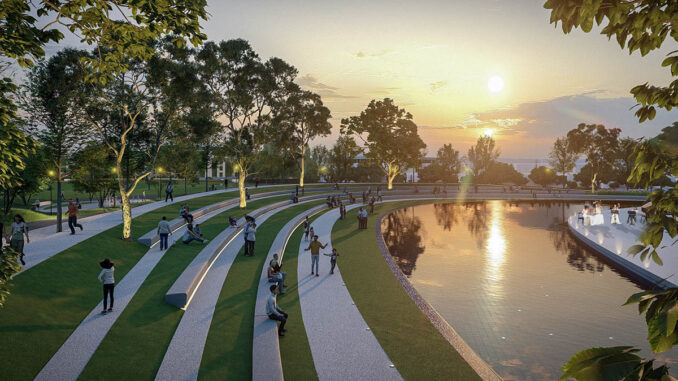
The island is envisioned as a vibrant hub bustling with cultural and recreational activities. From public music concerts and captivating art exhibitions to engaging science workshops, the facilities cater to a diverse range of interests and age groups. Educational programs, with a primary focus on traditional Chinese music and arts, aim to ignite the imagination and inspire the next generation of young minds.
Architecture: A Symphony of Contemporary Design
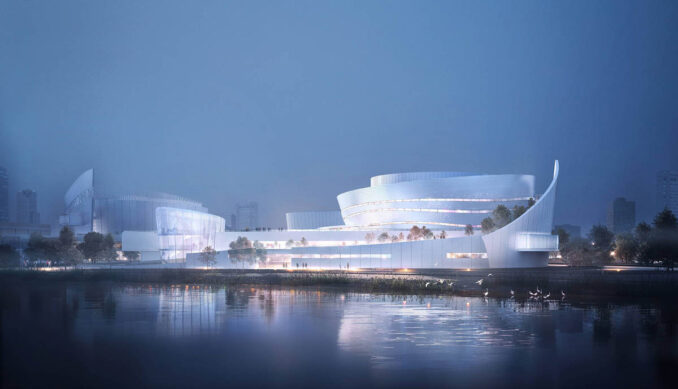
Echoes of Tradition in Modern Skies
Renowned for its harmonious blend of tradition and modernity, Jiangyin captivates with a delicate balance of architectural styles. The island’s new structures epitomize contemporary design principles, while the overall layout pays homage to traditional urban patterns—diverse and complex. Conceptually inspired by the elements of nature and music, the Music Center buildings evoke the ethereal beauty of billowing clouds, gracefully juxtaposed against symbolically flowing water on the ground.[3] Spiraling forms of the buildings mirror the crescendo of musical compositions, while repetitive vertical elements evoke the essence of musical instruments. Historic buildings undergo meticulous restoration for adaptive reuse, seamlessly integrated with modern glass box additions that respectfully preserve the integrity of their historic facades.
Master Plan: A Harmonious Composition
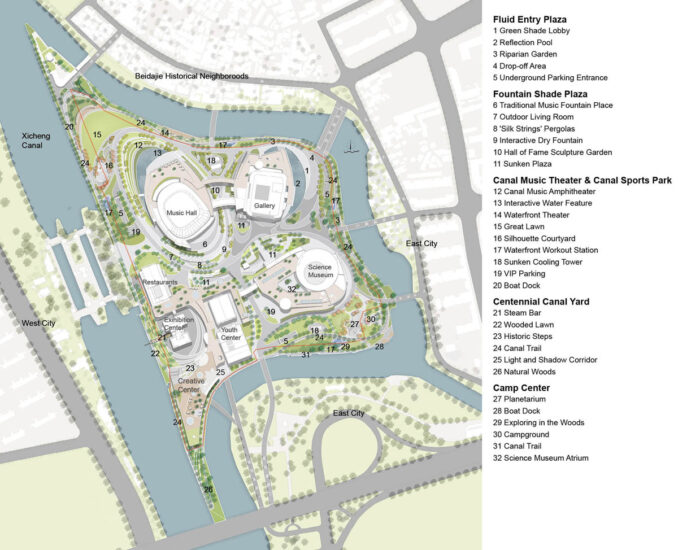
The site program interlaces a myriad of elements, including theaters, gardens, pools, fountains, outdoor courtyards, plazas, lawns, and various gathering spaces, along with health circuits, sports and exercise areas, children’s play zones, woodlands, campgrounds, and a redeveloped waterfront. Despite the diversity and complexity[3] of these components, the design of public spaces harmoniously unfolds as a fluid musical composition. Each element seamlessly transitions into the next, creating a symphony of movement and rhythm that invites visitors to embark on a journey of exploration and discovery.
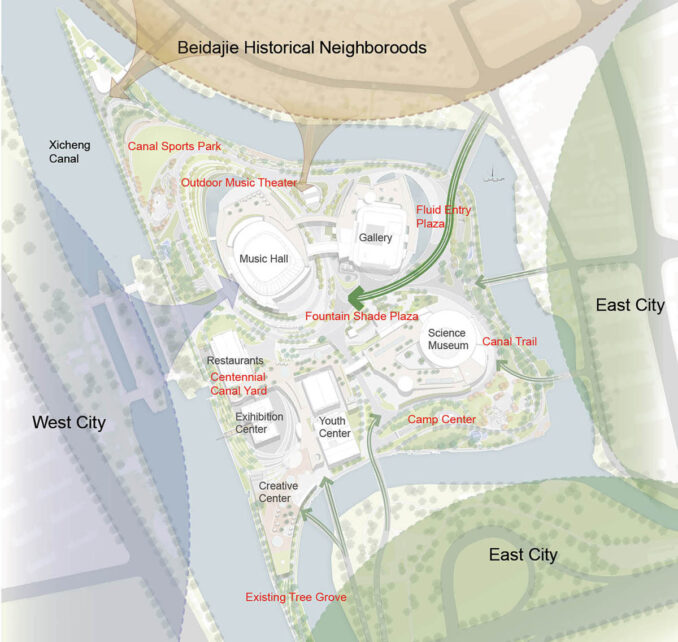
Entry and Arrival Experiences: Contextually Inspired Journeys
Nine distinct arrival sequences orchestrate a symphony of experiences, each choreographed to accentuate both the starting point and the destination. These pathways encompass adjoining districts on all four sides of the island, offering diverse and immersive encounters. To the north, connections evoke the ambiance of traditional neighborhoods, steeped in history and nostalgia. The primary entrance from the northeast unfolds into the site, leading guests to a central space, where the soul-stirring melodies of traditional music performances resonate. Meanwhile, the western arrival offers a unique industrial journey, guiding visitors through an operational canal lock system transformed by verdant park plantings, melding authenticity with a contemporary landscape. Several entrances from the south emerge from a lush forest belt, seamlessly extending the natural landscape onto the site, inviting guests on a journey of serenity and discovery.
Key Spaces and Elements: Harmonizing Tradition and Innovation
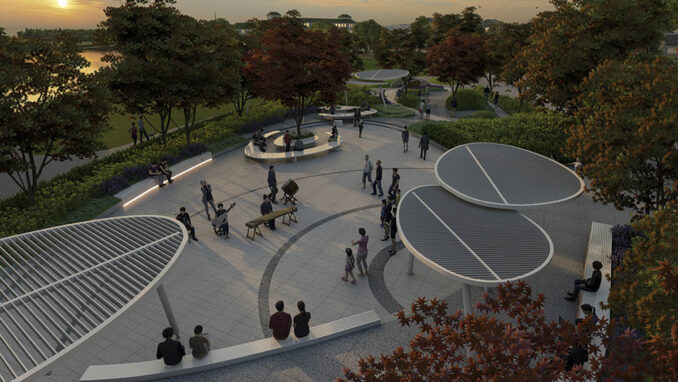
Central to Jiangyin’s cultural fabric is Jiangnan sizhu, a traditional Chinese instrumental music style originating from the Jiangnan region. “Sizhu,” translating to “silk and bamboo,” originally denoted string and wind instruments, with silk being the traditional string material in China. Over time, sizhu has evolved to encompass instrumental music as a whole.[4]
The Silk Music Courtyard stands as a homage to this rich musical heritage, providing an intimate and inviting space for enthusiasts of folk music. Here, visitors are enveloped in an atmosphere reminiscent of historic woodlands, evoking a sense of timelessness and tranquility. Contemporary shade structures, symbolic of the Pipa—an iconic silk string instrument—dot the landscape, serving as artistic representations that bridge the past with the present. These abstract interpretations not only honor the island’s historical roots but also acknowledge the dynamic cultural changes unfolding across China. Indeed, sizhu’s evolution as the foundation of the modern Chinese orchestra serves as a testament to the enduring spirit of innovation and adaptation.
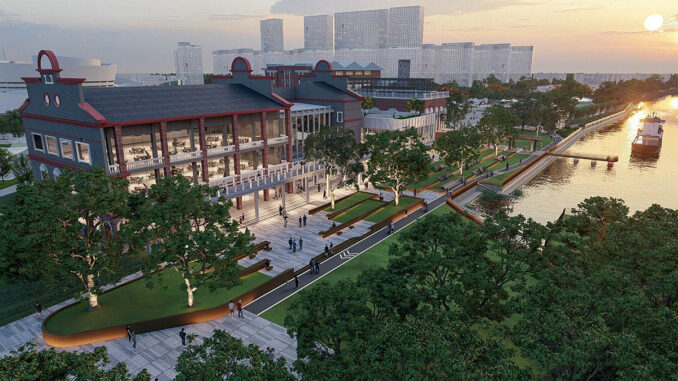
A redeveloped industrial waterfront intertwines repurposed yarn factory buildings, a transformed historic canal lock park, and a grand canal promenade. This dynamic space harmonizes modernity with nods to its industrial past, where historic references are abstracted and reimagined. For instance, iconic folded metal roof structures characteristic of industry are symbolically echoed in the design of folded bench forms. Furnishings throughout the area are contextually inspired, evoking the heritage of the nearby shipyards through their forms and materials.
Functioning as a versatile promenade, the space integrates tiered seating and lush lawn panels, inviting visitors to relax and enjoy the waterfront ambiance. Pergola-covered cafes offer shaded retreats, while gardens and a health circuit provide opportunities for recreation and rejuvenation.
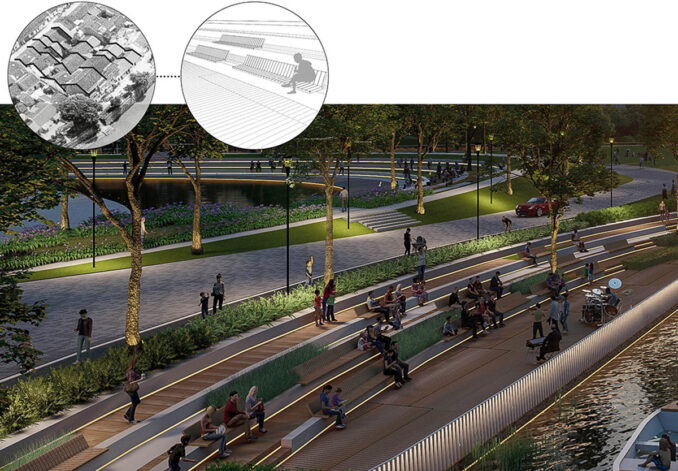
Drawing inspiration from the distinctive repetitive tile roof lines of the neighboring Beidajie Theater, the planar benches in this image employ open joints within large plank wood panels. These design elements serve as abstract references to this cultural icon, creating a visual dialogue that honors the theater’s historic significance while infusing the space with a sense of continuity and connection to the surrounding heritage.

Nestled within the Cultural and Creative District, a rooftop bar boasts a dedicated kid’s zone. Here, a delightful assortment of large-scale play structures awaits, including the beloved “Maxi,” a big spotted dog complete with long ear slides. Crafted from EPDM, a soft synthetic rubber material, these play structures are designed to spark imagination and encourage exploration. Perforations in the material facilitate climbing, passage, and games of hide and seek, while also creating dynamic interplays of light and shadow, adding to the enchantment of the space.
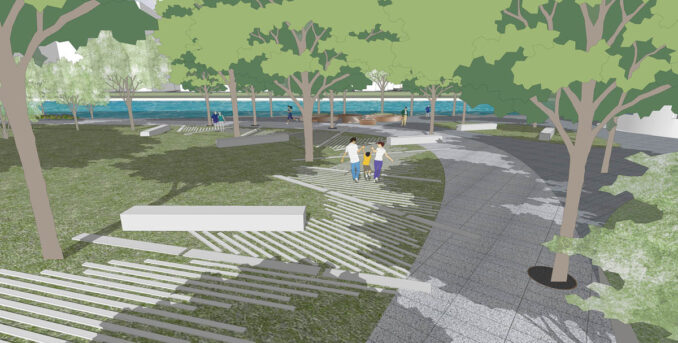
A preserved grove of historic camphor trees stands as a living testament to the island’s rich history. This tranquil space serves as a poignant link to the past, providing a serene retreat for activities such as tai chi and senior courtyards. Beneath the dense, sprawling canopies of these majestic evergreens, generations of users find shelter and solace. With its fragrant flowers and enduring presence, the camphor tree imparts a sense of nostalgia and reverence to the setting. Here, amidst the intermittent tranquility and activity, visitors are invited to reflect on the island’s enduring legacy and embrace moments of serenity.
Achieving Comprehensive Integration: Sustainability in Campus Design
Across the campus design lies a commitment to comprehensive sustainability practices, seamlessly blending environmental stewardship, community engagement, cultural enrichment, and regional economic advancement. Embracing a quadruple bottom line approach, these practices synergize to create a holistic framework for sustainable development.
Environmental initiatives encompass a range of strategies, including stormwater management and filtration systems, the creation of urban wildlife habitats, the cultivation of native plant species, urban forestation efforts, and the preservation of mature trees for carbon sequestration.
Community vitality is nurtured through initiatives that foster neighborhood connectivity, promote health and wellness through designated exercise areas and health circuits, offer environmental education programs, provide versatile activity spaces, offer performance venues, and create engaging children’s adventure play areas.
By integrating these diverse initiatives into the fabric of campus design, designers strived to not only minimize environmental impact but also enhance community well-being, celebrate cultural heritage, and stimulate economic growth, laying the foundation for a sustainable and thriving future.
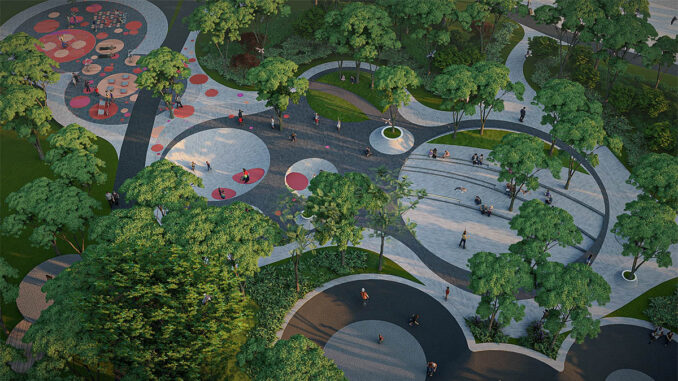
At the heart of the project lies a celebration of art, culture, and innovation, with a particular focus on traditional Chinese music alongside environmental sculpture and storytelling. The rehabilitation of industrial buildings and maritime artifacts, outdoor theaters, concerts, and educational programs collectively establish this site as a cultural tourism destination. Outside the Youth Palace, a Mars-themed discovery playground extends the realm of exhibitions and class activities outdoors, igniting curiosity and fascination with space and science.
Economic forecasts anticipate that the National Chinese Music Center will attract upwards of three million regional visitors per year. Many of these visitors are expected to spend multiple days on the campus, immersing themselves in various destinations, performances, and programs. This influx of visitors will stimulate the local economy, driving business to hotels, restaurants, cultural facilities, and shops in the vicinity. Potential redevelopment in the immediate area is likely, further revitalizing the surrounding community.
Reinforcing Cultural Legacy and Natural Heritage
The National Chinese Music Center stands as a tribute to Jiangyin’s illustrious cultural heritage, which spans millennia. This legacy encompasses a tapestry of breathtaking gardens, picturesque landscapes, revered cultural landmarks, vibrant festivals, renowned textile design, groundbreaking advancements in science and engineering, historic waterfronts, and even ancient ruins. However, at the core of the center’s mission lies a profound celebration of music, firmly establishing Jiangyin as the historical heart of Chinese traditional music.
Music serves as the cornerstone of this cultural narrative, resonating deeply with the region’s identity and history. From the rich tapestry of traditional forms and indigenous folk melodies to the dynamic evolution inspired by global influences, Chinese music reflects a harmonious blend of tradition and innovation. Today, it stands as a testament to the enduring legacy of Jiangyin, rooted in both its storied past and its embrace of global culture.[5]
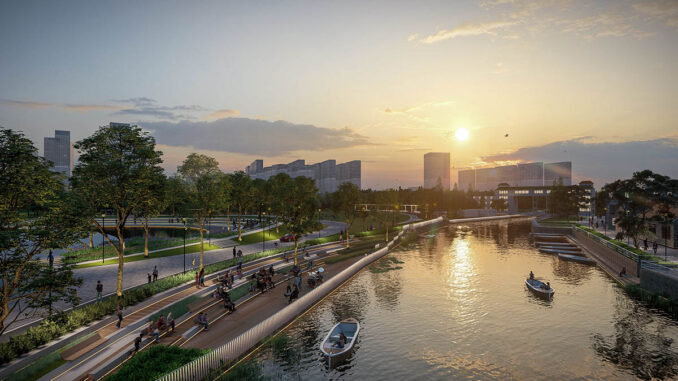
In this reimagined landscape, the campus serves as a harmonious bridge, seamlessly blending tradition with modernity while showcasing Jiangyin’s vibrant cultural tapestry alongside its natural splendor. Choreographed with melodic precision, the scenery unfolds as a figurative chorus of nature, with mountains, rivers, and the harmonious melodies of singing birds weaving together to create a scene reminiscent of classical Chinese landscape paintings. Here, echoes of ancient philosophers meditating and playing instruments in bucolic settings come to life, evoking a sense of timeless serenity and contemplation.
The landscape of the National Chinese Music Center embodies the belief in music as a powerful tool for personal reflection, civic engagement, and communion with nature. Often referred to as Music Island, this enclave holds profound significance in the preservation, promotion, and continued development of traditional Chinese music, ensuring its enduring legacy for generations to come.
References
[1] Hesse Shanghai, China Music Island, https://hesseshanghai.com/en/culture/china-music-island.html
[2] Stringed Music in China https://en.wikipedia.org/wiki/Stringed_music_in_China#:~:text=Stringed%20music%20is%20prominent%20in,zheng%2C%20erhu%2C%20and%20pipa
[3] CCTN Architectural Design, Jiangyin Beimen Island Chinese Traditional Music Center, http://www.acctn.com/casexq.html?content=174
[4] https://en.wikipedia.org/wiki/Jiangnan_sizhu
[5] https://facts.net/world/cities/33-facts-about-jiangyin/
National Chinese Music Center | Jiangyin, China | TOPOS
Text Credit: Charles Ware, Author; Yi Zhu, Author
Location: Jiangyin, China
Landscape Design: TOPOS, https://www.toposla.com/
Lead Landscape Architect: Yi Zhu, PLA, ASLA
Collaborators: CCTN Architects
Client: Jiangyin Urban Development Group
Conceptual Image Credits: TOPOS Landscape Architects
Photo Credits: TOPOS Landscape Architects

Be the first to comment